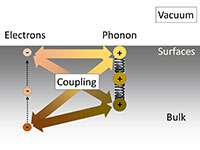Material surfaces are not just two-dimensional, researcher discovers

A physical science process that may yield a profound understanding for developing future nanomaterials—such as those used in cellphones or computer chips—was recently demonstrated and confirmed by a University of Wyoming researcher.
TeYu Chien, a UW assistant professor in the Department of Physics and Astronomy, was lead author of a paper, titled "Electron-Phonon Coupling in a System With Broken Symmetry: Surface of Be (0001)," that was recently published in Physical Review B. It is the largest and most comprehensive international journal that specializes in condensed matter and material physics, and publishes papers on a wide range of topics.
Chien and his research team focused on the interaction between electrons and ion vibrations (called "phonon") at the surfaces of beryllium crystal and revealed that, for the first time, the interaction between electron and phonon at the surfaces is determined by all four major entities: electrons in bulk, electrons at surfaces, phonon in bulk and phonon at surfaces. In particular, the broken symmetry induced surface electrons and phonon play a decisive role to enhance the electron-phonon interactions at the surfaces.
Beryllium crystal is used because it is a light material (fourth lightest on the periodic elements table behind only hydrogen, helium and lithium) that tends to have a high vibration energy, Chien explains.
Chien revealed that the presence of the surfaces that terminated the continuum of the materials is key to enhancing many body interactions in solid materials.
"The surface and bulk are not separate. Bulk materials have considerable large volume, sort of infinitely large for the electrons that live in it. But, all bulk materials are always contained inside their surfaces," Chien says. "The presence of the surfaces that stop the continuum of the materials spanning through the space is called 'broken translational symmetry' or simply 'broken symmetry.'
"But, it is an important question to think about. What is the cause of the dramatically different physical properties on the surface compared to their bulk counterparts: the broken symmetry or the lower dimensionality? The answer for this question is crucial for understanding nanomaterials."
Scientists know that nanoscale materials tend to have significantly different physical properties from their bulk counterparts, owing to their high surface-to-volume ratio. It is widely accepted that, due to the 2-D nature of the surfaces, electrons and ions behave dramatically different on the surfaces of materials compared to when they are inside the materials. Beyond the electron or ion properties at the 2-D surfaces, the interactions between electrons and ions are even more complicated at surfaces.
"Until now, it was not well understood that the extraordinary properties found at the surfaces of materials are the results of the low dimensionality or of the broken symmetry," Chien says.
In principle, low dimensionality, such as 2-D, only allows electrons to move freely in two dimensions (x and y direction on surfaces, the direction normal to the surface is not allowed); while the broken symmetry describes the asymmetric environment in the space, in which the space that electrons could move is stopped by the presence of the surfaces, he says.
"We focused on the electron-phonon coupling (EPC), one of the most studied forms of many-body interactions in physical systems, to address this question," Chien says.
The EPC is the mechanism responsible for conventional superconductivity, a status when materials exhibit zero resistance for conducting electrons. Strong EPC tends to drive superconductivity at higher temperatures. The strongly enhanced EPC on beryllium surfaces has been observed for decades without knowing the reason. The understanding was mainly obscured due to the complex interactions for the involved electron and phonon subsystems, Chien says.
"For nanoscale materials, almost all atoms are on the surface," he says. "Surface properties dominate the properties of nanomaterials. We are trying to provide information to scientists as to why and the possibility to design and develop future nanomaterials."
All of the complex analysis conducted during this study was made possible by using the state-of-the-art, angle-resolved photoemission spectroscopy (ARPES) and synchrotron radiation facilities in Lawrence Berkeley National Laboratory, Chien say.
More information: "Electron-phonon coupling in a system with broken symmetry: Surface of Be(0001)." Phys. Rev. B 92, 075133 – Published 21 August 2015 dx.doi.org/10.1103/PhysRevB.92.075133
Journal information: Physical Review B
Provided by University of Wyoming




















